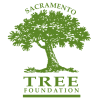Another successful year of saving the elms
by Taylor Elgin
September 1, 2023

Sacramento’s historic elm trees helped us earn the title of City of Trees. Unfortunately, our beloved elms are being threatened by the incurable Dutch elm disease (DED). Each year, the Tree Foundation partners with City of Sacramento Urban Forestry to train community scientists to help monitor these trees and prevent the spread of DED.
This year, we were happy to welcome 11 new monitors and welcome back six veterans – more than double the monitors for the 2021 and 2022 seasons! This season, five cases of DED were reported to the city, four of which have been confirmed and removed to prevent the spread of disease. These cases make up nearly a third of the reported number of cases to the city each year. The first DED-positive tree was identified by Thea and Mario, a mother and son duo who joined the Save the Elms program (STEP) this spring. This year’s group joins the hundreds of volunteers who have monitored the elms over the years. Without their care and dedication, we would not have many elms left in our beautiful City of Trees.

What is Dutch Elm Disease (DED)?

Dutch elm disease is an invasive fungal infection affecting which trees—just elms? The highly contagious and fatal disease can be spread by elm bark beetles or through root grafts (where roots overlap underground). While there are many factors that determine how long a tree can survive with DED, the disease can still kill a mature tree in a matter of weeks.
Signs of DED include:
- Leaves that droop and curl with a distinctive droop in the petiole (the leafstalk)
- Leaves that turn yellow, then brown
- Diseased leaves that spread in lines up/down one side of the tree
- Small holes where adults emerge from bark or bark beetles present on tree

Once cases are reported, they are inspected by the City of Sacramento to confirm the presence of DED and then removed to prevent the invasive disease from spreading to other elms. Salvageable logs may be delivered to our Urban Wood Rescue (UWR) yard which can provide a second life for these elms. To learn more about the UWR program, visit sactree.org/urbanwoodrescue or stop by our yard at 6045 Midway Street (Depot Park) in Sacramento open Thursday – Saturday (8:00 A.M. – 3:00 P.M.).
How do I become a DED monitor?
The monitoring season lasts from May through September, which is the best time to spot symptoms of DED before the leaves begin to drop in the fall. Volunteers can check back on our website next spring for training dates and registration information for the 2024 season. Volunteers who sign up will receive training on how to identify and report Dutch elm disease.
While sign-ups for the 2023 season may be closed, you can still support this valuable work by making a gift to the Tree Foundation. Your gifts help support programs like STEP and Urban Wood Rescue to help protect and save our city’s elms.
